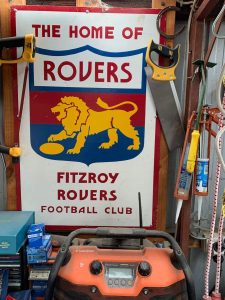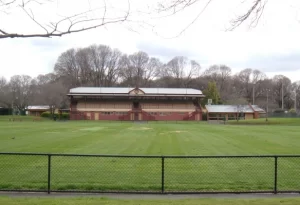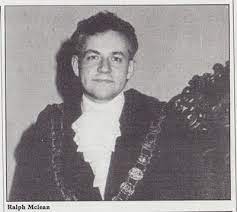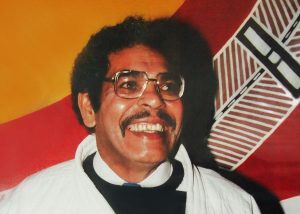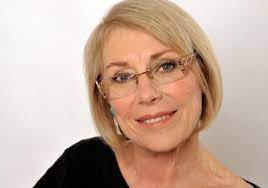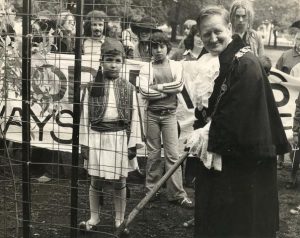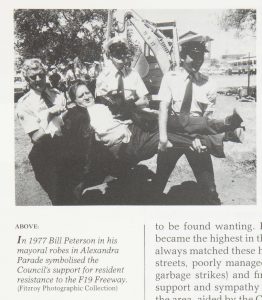Soon after I moved to a share house in Fitzroy in 1980, the year after having finished Uni, I went down to the Brunswick Street Oval and joined the local footy team- the Fitzroy Rovers. The oval was formerly home to the Fitzroy Football Club in the Victorian Football Association from 1884 to 1896, and in the Victorian Football League from 1897 until moving from the ground 1966.
Fitzroy legends of the game like triple Brownlow medallist Hayden Bunton and Kevin Murray had played much of their footy at the ground.
It was also where (Pastor) Doug Nicholls played. In 1935, he was the first Aboriginal player to be selected to play for Victoria’s interstate team, ultimately playing four interstate games. He played a total of six seasons for Fitzroy. At only 5’2′, he was short but lightening fast and highly skilled.
Nichols was also politically active. He became secretary of the Aboriginal Advancement League and played a leading role in lobbying and campaigning for the successful 1967 referendum. This referendum enabled the Commonwealth to make laws specifically for indigenous Australians and to include them in the census. It also removed provisions in the Constitution which said that ‘aboriginal natives’ should not be counted in the population. Nichols was subsequently knighted and in 1976 became governor of South Australia at the nomination of then Premier Don Dunstan. He only served briefly as Governor due to a sudden deterioration in his health.
Pastor Doug Nicholls- playing days
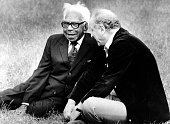
Pastor Sir Douglas Nicholls with Minister of Aboriginal Affairs, Clyde Holding at the Worawa College corroboree at Burnley Oval, 21 November 1983.
Before joining the Fitzroy Rovers the last football side I had played footy with was Monash University. Fitzroy was already gentrifying when I moved into the share house there. Most of the other members of the share house had also been to Monash. But there were probably only two other university graduates playing for the Fitzroy Rovers- Jim Pasinis- the captain and ruckman, and for a while Captain-coach and Philip Hind, a friend of mine who I had suggested come and play for the club after a few years of my having started there.
Most of the team were from working class families, from a mixture of Anglo-Saxon, Greek or other southern European backgrounds. Most of the players no longer lived in Fitzroy but went back there to play footy with friends that they had grown up with there. One of the best player’s Greek immigrant family owned a very successful butcher shop which was still located in Fitzroy. The only ones who I remember as still living in Fitzroy were the Horachek brothers. They resided in the high rise Housing Commission tower up the other end of Brunswick Street from the ground.
The Rovers had formed in 1976. They were founded by Big Joe Jurewicz, who, although not indigenous himself, had previously played with the Fitzroy Stars, Fitzroy’s indigenous team. After their founding the Rovers shared the Brunswick Street Oval with the Stars, the clubs playing their home games on ground on alternating weeks. But the two clubs played in different Leagues. Some how the Rovers ended up in the Western Suburban League though Fitzroy is not a western suburb.
The two clubs played practice matches against each other. These generally went well, although from time to time both clubs had problems with their supporters.
The Fitzroy Rovers were quite a successful team. We played against teams like Newport, Sunshine Heights, Werribee and Hopper’s Crossing. We usually at least made the finals. The seconds won a flag, and the senior team made a Grand Final against arch-rivals Werribee. I played in that Grand Final. But we were thrashed. News of the Grand Final made the Herald Sun. But not because of the footy. The story reported that several of our supporters had been charged with affray after alcohol fuelled fights broke out, not on the ground, but amongst the crowd.
The Brunswick St Oval still had a lot of atmosphere. It was located within the picturesque Edinburgh Gardens. Its playing surface was bigger and better than your average amateur footy ground.
The main ground had retained its historical, heritage listed, grandstand.
During the period when I was playing with the Rovers, the grandstand, which was located on the northern wing of the ground, was restored and a new function centre was constructed.
Apart from the main oval, and the gardens themselves, the park was also host to a bowling green, tennis courts, and a smaller oval behind the main oval with no grandstand, and a rougher surface and that was only big enough for junior footy.
Originally in addition to the main grandstand on the Northern wing the Ground had a smaller stand closer to Brunswick Street, on the Western side of the ground, the Hayden Bunton Stand. It burnt down after one of the Fitzroy Stars matches. Subsequently a smaller pavilion was built on the Eastern side of the ground which was named the Hayden Bunton pavilion. The teams used this as change rooms and for social functions.
The Hayden Bunton Stand (foreground) and the main Grandstand.
When council planned to restore the grandstand, incorporating some new change rooms and a to build a new function centre next to its Eastern side, the future of the Hayden Bunton pavilion came under focus.
The Rovers wanted to keep the pavilion and suggested that the redevelopment be re-planned with new function centre being located nearer to Brunswick Street on the Western side of the Grandstand. The Rovers lobbied the Labor Party in relation to the re-planning the development.
John Finlayson, a member of the Party, a youth worker in Fitzroy for many years and a pivotal figure in the foundation of the Fitzroy Legal Service, led the charge on the effort to replan the development so that the pavilion would be retained.
There was lots of lobbying over the re-development with quite a bit of money at stake. With the removal of the original walls around the ground (also part of the redevelopment) nearby residents’ property in Freeman Street adjacent to the southern side of the ground would see their home prices leap in value with the new views across the ground and some of these residents may have regarded the Hayden Bunton pavilion as an eyesore.
Although the Rovers administration had been assured nothing would happen to the Hayden Bunton pavilion until the after Council had considered and decided upon the proposed re-plan the Hayden Bunton pavilion was bull-dozed. From then the Rovers did not think highly of the Council.
The view from Freeman Street across the ground to the main grandstand after its renewal and the new function centre just to the right.
At some stage, the Stars were no longer permitted to play in the league they were in, the Metropolitan League, and they left the Brunswick Street Oval. After this the Rovers shared the ground for home games on alternating weeks with a Spanish soccer club, which was linked to the Spanish Club, established in Johnston Street Collingwood from 1969.
The Spanish Club- Johnston Street, Fitzroy
Like a lot of amateur teams, the Fitzroy Rovers struggled to stay afloat. Money was always a problem and there was a shortage of people willing or able to perform administration. The players knew I was a lawyer and so, a few years in, around 1982 or 83, it was put on me to go on the committee as secretary. I really didn’t want to do it. I was only interested in playing footy. But it was presented to me as a necessity- If someone didn’t do the role the club might well fold. And so, I agreed.
I think it was either ’83 or ’84 when I was still secretary that an unforeseen existential issue cropped up for the club.
The problem was that the Fitzroy Stars wanted to return to their original home in Fitzroy. And there were apparently some Fitzroy councillors who were strongly minded towards facilitating this. So there were three teams wanting to share one oval which only had room for two. Someone, it seemed, had to lose out.
When I was told that the Council had an affirmative action policy in favour of Aboriginal people it appeared to me that, despite our current occupation of the ground, we might encounter difficulties in getting to remain there. My first informal chat with councillors who were members of the Edinburg Gardens sub-committee did little to allay to my fears. This sub-committee would report back to the whole Council who would make the final decision, probably following the sub-committee’s recommendation.
I was sympathetic to the idea of an affirmative action policy for Aboriginal people as a means of addressing historical disadvantage. And I also liked the Spanish presence in Fitzroy and had started learning Spanish a year or so earlier. But, as secretary of the club, my job was to defend its position and it also had strong arguments as to why it should be allowed to stay at the ground.
As word spread around the club that we might lose the ground to the Stars the reaction amongst some of the Rovers was ugly. Hostility grew towards the “trendy” council, its “poofta” mayor and even towards the Stars themselves.
According to one of the Horachek brothers, Aboriginal people (I doubt how that’s how he referred to them) already enjoyed more services in Fitzroy with their free doctors and lawyers than people like his family did. The Aboriginal Legal Service and Aboriginal Health Service were both located in Fitzroy.
The reference to the ‘poofta’ mayor was to Ralph McClean who served as mayor of Fitzroy in 1984 and 1985. Ralph was the first openly gay person ever elected as a mayor in Australia. First elected to Fitzroy Council in 1982 as a Labor Party councillor, he came out publicly as gay during his mayoral campaign in 1984 and won the election. Following his term as mayor of Fitzroy, he remained active in Melbourne’s arts and cultural community, including five years as chairman of the Melbourne Fringe Festival board, four years as chairman of C31 Melbourne, and a stint as executive director of the Australian Federation of AIDS Organisations. In 2014, the City of Yarra, the successor government to Fitzroy, unveiled a public monument to the city’s LGBT community which was dedicated in part to McLean.
Ralph McClean
I wracked my brain for a solution to the ground issue. Then, I came up with one. Or at least I thought I did. I arranged a meeting with aboriginal leader, the legendary Jock Austin, to discuss my idea.
Jock Austin was one of the most revered leaders of the Aboriginal community in Victoria. From a young age, he displayed immense talent at sport, particularly football and boxing. He was the Stars coach and president. He has a page on a Victorian Government website dedicated to First Nations people from Victoria.
Jock Austin
“Jock, I’ve tried to think of a way all three teams can stay in Fitzroy. Our guys grew up in Fitzroy. We were once the same team. We shouldn’t be booted out. There is only one way I can think of for all three teams to stay in Fitzroy. The oval out the back. It is not big enough for senior footy. But it’s big enough for soccer. It’s not as good a ground. But it’s the only way everybody can stay in Fitzroy. We footy teams should stick together. We should support each other at the council”.
Jock seemed a little guarded. I don’t remember exactly what he said. It’s was probably wishful thinking on my part. But I left our meeting with the distinct impression that we had a deal. Both the Aussie Rules clubs would stick together at the meeting with council based on the idea that all three clubs should stay in Fitzroy and that the only way to achieve this was for the Spanish team to go onto the smaller space out the back. There was no grandstand there. But the playing surface could be improved and, because soccer only requires a smaller playing area than senior Aussie rules football, it was a viable solution.
I also spoke to the Spanish soccer club. I ran my idea past them. They were friendly and seemed to welcome my attempts to interlace our discussions with some Spanish. But unsurprisingly, they were not enamoured by the proposal for them to be relegated to the smaller playing field out the back from the main ground.
The council at this time, like most inner city councils, was still dominated by the Labor Party. I wasn’t in the Labor Party yet. But my father Clyde had been leader of the Labor Opposition in Victoria for 10 years and from 1977 had moved into federal politics. The Labor party had seemed to surround me my whole life.
Trish Caswell, who I would subsequently work with at the Victorian Trades Hall Council from the early 90’s, was on the council and on the Edinburg Gardens sub-committee. I had several discussions about the problem with her.
Trish Caswell
Kevin Healy was also on the Gardens sub-committee. He had been involved in organising safe houses for draft resisters during the Vietnam war. He took a strong-line on the right of the Stars to return to Fitzroy and in favour of the Spanish soccer club retaining its position on the ground.
And then there was Bill Petersen. He had been mayor of Fitzroy back in 1972-73 and then again in 1977-78 and had led protests in Alexandra Avenue against the F19 freeway. A working class Whitlamite Labor man, to my knowledge, he was the only member of the council sub-committee who had a strong conviction that it would be unfair to kick the Fitzroy Rovers off the oval.
Bill Petersen
At some point in this saga, before the decisive meeting, somebody told me to check whether the council really did have a formally adopted, affirmative action policy in favour of Aboriginal people. I have my doubts that it did. Because I asked for a copy but was never given one.
A formal meeting of Edinburgh Gardens sub-committee of council was convened to discuss the issue. Our assumption was that at this meeting each club would be given a fair opportunity to have its say on what should happen and that the councillors would listen to the arguments and then decide. I was going to argue for the “three team solution”. But if that was not accepted and it came down to a battle between us and the Stars, I was ready to argue that I had requested but not been given a copy of the affirmative action policy in favour of Aboriginal people and that, even if there was a policy, it still had to be considered and fairly applied with regard to all of the circumstances in the case.
The most important other relevant considerations were that the Spanish soccer club and the Rovers were already located at the ground, that the Rovers players had roots in Fitzroy, had done nothing wrong as tenants at the ground, and would fold if required to leave. The Stars on the other hand, had presumably been playing at other venues and could continue to do so without a threat to their existence.
I had asked our players to turn up at the meeting and they did ‘on masse’-about 40 of us jammed into a crowded meeting room.
I greeted the Spanish soccer club guys. But where was Jock Austin and the Stars’ representatives?
I was informed that they had been there earlier but had already left. It seemed obvious that the meeting was no more than a sham consultation and that they had left because they had already secured the sub-committee’s support to return to the ground. So much for the deal I thought I had with Jock Austin.
Looking back, the deal I thought I had was just likely a hopeful fantasy. A deal with us gave the Stars nothing that they could not achieve through their own means. They owed us nothing and had no reason to care whether they would share the ground with another Aussie Rules team or soccer players of Spanish origin.
We went through the motions in a firey meeting with the sub-committee. A few days later we learned that we would no longer be allowed to play at the ground.
But Bill Petersen was having none of it. He had contacts in YCW Football league, the league in which the Stars were playing or were going to play. He somehow convinced the YCW that if the Stars returned to the Brunswick Street Oval they should no longer be permitted to compete in the YCW League.
And so it was that the Fitzroy Rovers got to stay at the Brunswick Street Oval.
I was glad to have had the win. Glad that the Rovers had not lost the oval during my watch as secretary. Yet I couldn’t help being nagged by the thought “Damn, the aboriginals have lost again.”
But Fitzroy was changing.
Within just another season two the Rovers Club folded anyway. And many aboriginal people were already moving north to live. Today the Aboriginal Legal Service is based in Preston not Fitzroy. The health service still has an office in Fitzroy but also has offices in Preston Epping and St.Albans. The Fitzroy Stars are still going but they never returned to Fitzroy. Today they play in the Northern League. Their home ground is in Preston. It is named the Sir Douglas Nichols Oval.
In 1954 a Melbourne University team called the Reds formed from players who could not make the stronger Uni Blues or Blacks team formed. In 1991 they started using the Brunswick Street Oval. In 1998 the old VFL Fitzroy Football Club came out of administration and joined up with the Reds and now compete in the Victorian Amateur Football League from the Brunswick Street oval, now called the Bill Petersen Community Oval.
One of the members of the share house in Fitzroy was Bryce Menzies. His son Kai played 150 games with the Fitzroy Reds many of these on the Brunswick st/Bill Petersen Community Oval.

